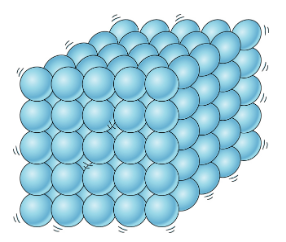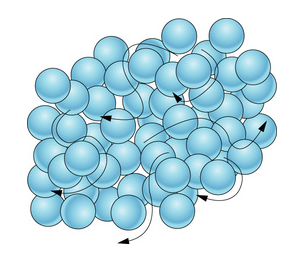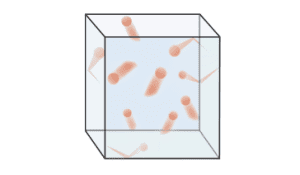Matter: States and Composition
Matter is anything that has mass and takes up space. It can be classified based on its state, physical form, or its composition, which includes the atoms or molecules that make it up.
Three States of Matter
The three states of matter are covered in greater depth in later units, but here is a brief description of each:
🧊 Solids
Solids have a fixed shape and volume because they are composed of densely packed atoms or molecules held together by strong chemical bonds. Due to this tight packing, particles in a solid can only vibrate slightly, maintaining the solid’s rigidity.

💧 Liquids
Liquids have a fixed volume but not a fixed shape. The particles are loosely packed, allowing them to move past each other, which gives liquids the ability to flow and take the shape of their container.

♨️ Gases
Gases have neither a fixed shape nor a fixed volume. Their particles are spread out and in constant, random motion, expanding to fill any container they occupy. Gases can be compressed easily because of the significant space between their particles.

Categorizing Matter by Composition
Matter can be divided into pure substances and mixtures based on its composition. Pure substances consist of only one type of atom or molecule, and their composition is consistent throughout each sample. Mixtures, on the other hand, will be discussed in the following section.
Pure Substances
Pure substances are composed of only a single type of atom or molecule, with a uniform and consistent composition across all samples.
Elements and Compounds
Elements consist of only one type of atom. For instance, gold (⚖️) is an element, as it is made entirely of gold atoms. You can find elements listed on the periodic table, which represents all the elements discovered by scientists.
Compounds are made up of two or more different elements bonded together. For example, water (Ὂ7) is always composed of two hydrogen atoms and one oxygen atom (₂H₂O), which makes it a compound. Another example is sodium chloride (ᾜ2), commonly known as table salt, which is composed of one sodium ion bonded to one chloride ion (NaCl).
Formula Units
Compounds consist of a fixed ratio of different atoms, and the smallest representative collection of atoms in a compound is called a formula unit. It represents the lowest whole-number ratio of atoms in a compound. For instance, in sodium chloride (NaCl), the formula unit is 1:1, meaning each sodium ion pairs with one chloride ion.
Example Problem: Formula Units
Problem: How many formula units of KCl would be needed if 1.76 mol KCl were used in a chemical reaction?
Using Avogadro’s number (6.022 × 10⁻²³ formula units per mole), multiply 1.76 mol by Avogadro’s constant to find the total number of formula units.
Law of Definite Proportions
The law of definite proportions, also known as the law of constant composition, states that the ratio of constituent elements in a pure chemical compound is always the same. For example, no matter how much water you have, the ratio of hydrogen to oxygen is always 2:1. Whether you have 100g, 200g, or even 5000g of water, the composition remains consistent.
Understanding the Law of Definite Proportions 🥜
Imagine following a recipe for chocolate chip cookies. The correct amount of flour, butter, eggs, and chocolate chips must be used to get the desired result. The proportions remain constant regardless of the number of cookies baked, ensuring consistency.
Similarly, in chemical compounds, the ratio of elements is fixed; otherwise, the identity of the compound would change.
Empirical Formula
The empirical formula of a compound represents the simplest whole-number ratio of atoms for each element in the compound. It gives a simplified version of the chemical composition.
The Empirical Formula of Glucose 🍬
For example, the molecular formula of glucose is C₆H₁₂O₆. The empirical formula, which represents the simplest ratio, is CH₂O. Note that while the molecular formula shows the actual number of atoms, the empirical formula only shows the simplest ratio, not necessarily the specific number or arrangement of atoms.
Glucose
Molecular Formula:
C₆H₁₂O₆
Empirical Formula:
CH₂O
Regardless of how complex the numbers in the molecular formula are—for example, C₉₀H₁₈₀O₉₀—the empirical formula would still be reduced to CH₂O.
Empirical Formula – Practice Question
Question: A carbohydrate containing carbon (C), hydrogen (H), and oxygen (O) has a percent composition of 33.3% C and 7.4% H. Find the empirical formula of this carbohydrate.
Follow these four steps:
Percent to Grams
Simply drop the percent symbol to convert from percentage to grams: 33.3g C and 7.4g H. We also know the compound contains oxygen, so we calculate the remaining percentage: 100% – 33.3% – 7.4% = 59.3g O.Grams to Moles
Convert these masses to moles using molar masses (C: 12.01 g/mol, H: 1.008 g/mol, O: 16.00 g/mol):C: 33.3g / 12.01 g/mol = 2.77 mol
H: 7.4g / 1.008 g/mol = 7.34 mol
O: 59.3g / 16.00 g/mol = 3.71 mol
Divide by Small
To get the simplest ratio, divide all mol values by the smallest:C: 2.77 / 2.77 = 1
H: 7.34 / 2.77 = 2.65
O: 3.71 / 2.77 = 1.34
Times to Whole
Since we have non-whole numbers, we multiply each value to achieve whole numbers. Here, multiply all by 3:C: 1 × 3 = 3
H: 2.65 × 3 = 8
O: 1.34 × 3 = 4
Thus, the empirical formula is C₃H₈O₄.







